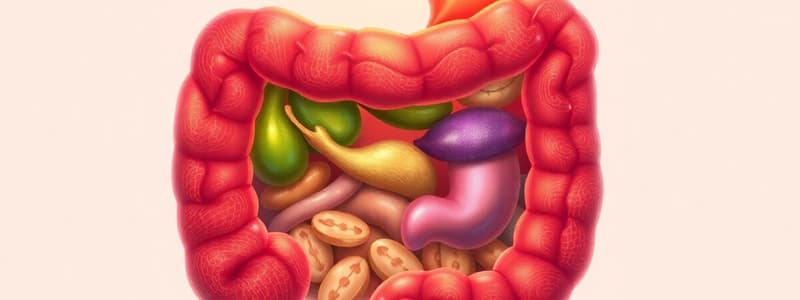Podcast
Questions and Answers
What is the length of the alimentary canal in living persons?
What is the length of the alimentary canal in living persons?
5 meters
What are the four basic digestive functions?
What are the four basic digestive functions?
Secretion, Motility, Digestion, Absorption
Which of the following is NOT a part of the digestive glands?
Which of the following is NOT a part of the digestive glands?
- Salivary glands
- Gall bladder
- Liver
- Kidney (correct)
What are the components involved in food digestion?
What are the components involved in food digestion?
The external anal sphincter is made of smooth muscle.
The external anal sphincter is made of smooth muscle.
What type of muscle is involved in gut motility?
What type of muscle is involved in gut motility?
Which type of gut motility is primarily responsible for the forward movement of food?
Which type of gut motility is primarily responsible for the forward movement of food?
What structure controls the rate of peristalsis?
What structure controls the rate of peristalsis?
The process of _____ involves the breakdown of complex molecules into simple ones.
The process of _____ involves the breakdown of complex molecules into simple ones.
What is the main function of mixing movements in the digestive tract?
What is the main function of mixing movements in the digestive tract?
Study Notes
Digestive System: Functional Structure & Processes
- Alimentary Canal: A muscular tube extending from the mouth to the anus, measuring 5 meters in living individuals and 9 meters outside the body.
- The lumen of the alimentary canal is continuous with the external environment.
- Digestive Glands:
- Salivary glands, liver, gall bladder, exocrine pancreas
- General Functions of the Gut:
- Food Digestion: Breakdown of complex molecules into simpler ones (e.g., carbohydrates into monosaccharides, proteins into amino acids, fats into fatty acids) for absorption.
- Requires secretion of digestive juices and wall motility.
- Food Absorption: The process of taking digested nutrients into the bloodstream.
- Excretion of Waste Products: Elimination of undigested and unabsorbed food.
- Immune Function: Defense mechanisms involving saliva, gastric HCl, rapid cell turnover, and lymphoid follicles.
- Food Digestion: Breakdown of complex molecules into simpler ones (e.g., carbohydrates into monosaccharides, proteins into amino acids, fats into fatty acids) for absorption.
Basic Digestive Processes
- Secretion: Release of digestive juices containing water, electrolytes, and organic constituents (enzymes and mucus) by glands along the gut wall.
- Digestive secretions are reabsorbed back into the blood after participating in digestion.
- Motility: Movement of materials through the digestive tract.
- Smooth muscles: Most of the GIT (Gastrointestinal Tract) is composed of smooth muscle, except for the upper third of the esophagus (skeletal muscle), middle third of the esophagus (skeletal and smooth), and external anal sphincter (skeletal muscle).
- Functional Syncytium: Smooth muscle cells of the gut function as a syncytium, allowing action potentials to travel in all directions.
- This creates a coordinated muscle contraction, controlling peristalsis and segmentation.
- Digestion: The breakdown of complex food molecules into simpler ones.
- Absorption: The uptake of digested nutrients into the bloodstream.
Types of Gut Motility
- Tonic Contractions: Sustained mild contraction of smooth muscles in the GIT wall, maintaining constant intraluminal pressure.
- Caused by spike potentials or calcium ion entry.
- Propulsive (Peristaltic) Movement: Responsible for moving food contents through the esophagus and intestines.
- Stimulus: Stretch or irritation of the mucosa.
- Response: Contraction behind (by Acetylcholine) and relaxation in front (by Vasoactive Intestinal Peptide [VIP] and Nitric Oxide [NO]) of the stretched segment.
- Control: Auerbach's plexus of the Enteric Nervous System (ENS), influenced by autonomic nerves.
- Mixing (Segmenting) Movement: Facilitates food digestion and absorption.
- In the stomach, peristaltic contractions mix food.
- Segmentation contractions: In the small intestines, constrictions divide the gut into equal segments, promoting food mixing.
- Haustrations: In the large intestines, mixing movements are referred to as haustrations.
Studying That Suits You
Use AI to generate personalized quizzes and flashcards to suit your learning preferences.
Related Documents
Description
Explore the essential functions and structural components of the digestive system in this quiz. Learn about the alimentary canal, digestive glands, and their roles in digestion, absorption, and waste excretion.




